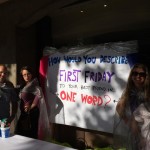It’s often difficult to track the “results” of heritage work. How does our work help address societal issues such as homelessness, identity, happiness, integration and safety?
Many argue that heritage activity has intrinsic value that positively affects those who participate in programming and projects, and that this alone justifies our necessity and funding. Consequently, we often minimize the depth and complex results of the work we do through research, program design and evaluation—and too rarely communicate how our work results in broader social impacts. Larger evaluative frameworks that track specific indicators of social change and real transformations in communities aren’t part of our approach to creating programs or projects.
This challenge was at the heart of Museum Camp 2014. As participants, we were challenged to work through some of these questions by developing a rapid prototype model and implement it over a 3-day period.
What is Rapid Prototyping?
Nina Simon first proposed borrowing rapid prototyping from the gaming industry in a 2009 Museum 2.0 blog post. In games development, rapid prototyping focuses less on rigorous planning before implementation and instead encourages a flexible development process based on rapid feedback loops, using the knowledge gained to adjust processes and evaluation and move towards achieving goals.
Her takeaways from this model were:
- if you abstract far enough, you can prototype interactions very quickly
- visitors have strategies
- you can design interactions to encourage “playing well,” i.e. in accordance with your organizational value.
Nina found that four aspects of Web 2.0 could be applied to physical spaces in our institutions:
- Venue as platform (the space isn’t a destination in and of itself but rather a place for engineering experimentation),
- Architecture of participation (heritage professionals have the power to engineer specific types of participation through design),
- Perpetual beta (constant testing, evaluating and adapting), and
- Modular support for plug-ins (not constructing the boundaries of our programs too tightly to stifle beneficial add-ons).
- Santa Cruz MAH groups implementing their rapid prototyping projects
- Santa Cruz MAH groups implementing their rapid prototyping projects
Using Rapid Prototyping in Heritage Programming
Rapid prototyping can be incredibly useful to the heritage sector for a number of reasons:
- It challenges complacency. Programming that worked twenty, ten or even five years ago may not have the same impact today. The demographics in Alberta, especially in urban centers have changed dramatically over the past 20 years. In Edmonton we gain at least 30,000 new residents per year from across Canada and around the world[1]. Creating rapid prototyping models and testing them can save us time and resources to respond to changing demographics.
- It makes the sector financially nimble. The prime motivator for an organization’s change often comes from securing funding to continue operations rather than responding to the changing social environment. Though we all face the reality of a funding environment that fluctuates with resource prices, Alberta is in one of the better funding environments in Canada. So funding aside, change should be motivated by the need to address important organizational questions around our organizations mission and its external facing work.
- It’s faster and more efficient. The typical program development process is often slowed by “unneeded levels of bureaucracy and inbred institutional resistance to change.” We may spend years thinking about the best way to offer a program that may not address the challenge by the time it’s offered.
- It reframes organizations as experience providers rather than service providers. We often frame those for whom we develop programs as customers and minimize our capacity for engagement. Customer relations at its broadest level could be argued to be a one-way transactional relationship. We provide a service for a fee—someone comes to us and receives the same experience as everyone else paying for the same experience. However, by framing ourselves as onsite experience providers, we recognize and honor that experiences are highly personal and vary completely according to each person, and that we embrace this role. Engaging communities through the process rapid prototyping helps form meaningful relationships, which speaks more closely to connections and experiences and less around delivering a service.
Rapid prototyping frees us from angst of perfection. We can still do really amazing and innovative work respectfully and meaningfully. As Mike Edson from the Smithsonian Institution says “Innovation happens at the margins”.
For more information, visit Nina Simon’s blog at Museum 2.0.
The Edmonton Heritage Council appreciates the support of Canadian Heritage through the CMA Bursary Program to attend Museum Camp 2014.
[1] http://www.edmonton.ca/city_government/news/2014/edmontons-2014-census-confirms-strong-population-growth.aspx

